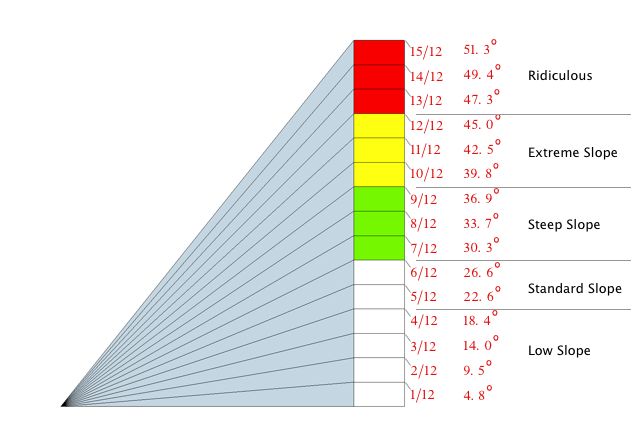Understanding Roof Pitch
"When it comes to roofing, it is function over form, with attention to form."
by Stefan Mach | Mar 15, 2016 | roofing terminology
Roof Pitch: Considerations and Cost
Roof pitch is what roofers call the angle of the roof relative to a horizontal line. It can be measured in degrees or what is known as “pitch”. Pitch is further defined as rise over run. A roof that rises 4 inches vertically for every 12 inches horizontally is said to have a 4/12 pitch. A roof that has the same rise as it does run is said to have a 12/12 pitch. A 12/12 pitch is also a 45° angle.
Considerations
A roof that is under a 6/12 or 7/12 pitch will typically be considered an easy roof by your average roofer. Pitches under 4/12 require an ice and water shield membrane to be put underneath of the entire area being covered with shingles. Installing shingles on pitches under a 2/12 pitch is really pushing it and further “best practices” should be utilized. Considering that an architectural shingle like the Certainteed Landmark is wedge shaped top to bottom, which results in modest pitch being removed from the roof, a wise choice under 2/12 pitch would be to use the single tab Certainteed Patriot shingle. This shingle is a vast improvement over the 3 tab, while still being consistent in thickness top to bottom, so there is no reduction in pitch. It is this roofer’s opinion that 1/12 is simply to low for shingles, but that if it must be done, the shingle exposure can be reduced to provide additional coverage of the nails, as well as at the joints. Keep in mind that this is not considered by most if not all manufacturers to be an acceptable practice, and can result in additional windlift, with resulting blowoff of shingles. Make sure that if you go for this option, your roofer understands the variables, and can intelligently explain why he/she thinks you can opt for this solution.
Roof pitches between 7/12 and 9/12 are considered standard by roofers but steep by insurance companies. While many roofers will not increase cost for pitches in this range, insurance companies will make adjustments to their expected expense.
Roof pitches 10/12 to 12/12 are considered steep by most roofers and extreme by most insurance companies. Both roofers and insurance companies will usually make adjustments to the total cost of a project within this range. As an added note, insurance companies will increase total expense to them if a roof is two stories or higher, whereas most roofers do not consider height an issue until the roof is above 3 stories. This is of course not a hard and fast rule, but a general observation.
Roof pitches above 12/12 are considered “ridiculous”. This is of course a technical term, and is employed by most roofers as well as most insurance companies. Just kidding!LOL. You won’t find many pitches this high. Maybe on the occasional turn gable.
The final pitch range before you hit a vertical wall is not typically designated by the ?/12 designation, but rather is called a “mansard” roof. You have probably seen homes that have shingles on their second story wall, and further observed that this wall is slightly leaning away from the vertical plane. The pitch is likely around 96/12, or 8 feet of rise for 1 foot of run. Roofing these surfaces involves the use of pump jacks and planks, and lots of ladder work if no pump jacks and planks are available. There will always be an increase in cost when it comes to this very slow going work.
Thanks for reading.


